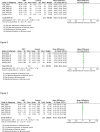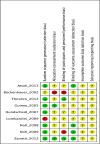Chronic inflammatory disease and osteopathy: a systematic review
- PMID: 25781621
- PMCID: PMC4363664
- DOI: 10.1371/journal.pone.0121327
Chronic inflammatory disease and osteopathy: a systematic review
Abstract
Background: Chronic inflammatory diseases (CID) are globally highly prevalent and characterized by severe pathological medical conditions. Several trials were conducted aiming at measuring the effects of manipulative therapies on patients affected by CID. The purpose of this review was to explore the extent to which osteopathic manipulative treatment (OMT) can be benefi-cial in medical conditions also classified as CID.
Methods: This review included any type of experimental study which enrolled sub-jects with CID comparing OMT with any type of control procedure. The search was conducted on eight databases in January 2014 using a pragmatic literature search approach. Two independent re-viewers conducted study selection and data extraction for each study. The risk of bias was evaluated according to the Cochrane methods. Heterogeneity was assessed and meta-analysis performed where possible.
Results: 10 studies met the inclusion criteria for this review enrolling 386 subjects. The search identified six RCTs, one laboratory study, one cross-over pilot studies, one observation-al study and one case control pilot study. Results suggest a potential effect of osteopathic medicine on patients with medical pathologies associated with CID (in particular Chronic Obstructive Pul-monary Disease (COPD), Irritable Bowel Syndrome, Asthma and Peripheral Arterial Disease) com-pared to no treatment or sham therapy although data remain elusive. Moreover one study showed possible effects on arthritis rat model. Meta-analysis was performed for COPD studies only show-ing no effect of any type of OMT applied versus control. No major side effects were reported by those receiving OMT.
Conclusion: The present systematic review showed inconsistent data on the effect of OMT in the treatment of medical conditions potentially associated with CID, however the OMT appears to be a safe approach. Further more robust trials are needed to determine the direction and magnitude of the effect of OMT and to generalize favorable results.
Conflict of interest statement
Figures



Similar articles
-
Comparison of the effectiveness of inhaler devices in asthma and chronic obstructive airways disease: a systematic review of the literature.Health Technol Assess. 2001;5(26):1-149. doi: 10.3310/hta5260. Health Technol Assess. 2001. PMID: 11701099
-
Drugs for preventing postoperative nausea and vomiting in adults after general anaesthesia: a network meta-analysis.Cochrane Database Syst Rev. 2020 Oct 19;10(10):CD012859. doi: 10.1002/14651858.CD012859.pub2. Cochrane Database Syst Rev. 2020. PMID: 33075160 Free PMC article.
-
Systemic pharmacological treatments for chronic plaque psoriasis: a network meta-analysis.Cochrane Database Syst Rev. 2021 Apr 19;4(4):CD011535. doi: 10.1002/14651858.CD011535.pub4. Cochrane Database Syst Rev. 2021. Update in: Cochrane Database Syst Rev. 2022 May 23;5:CD011535. doi: 10.1002/14651858.CD011535.pub5. PMID: 33871055 Free PMC article. Updated.
-
Manipulative therapies for infantile colic.Cochrane Database Syst Rev. 2012 Dec 12;12(12):CD004796. doi: 10.1002/14651858.CD004796.pub2. Cochrane Database Syst Rev. 2012. PMID: 23235617 Free PMC article.
-
Immunostimulants versus placebo for preventing exacerbations in adults with chronic bronchitis or chronic obstructive pulmonary disease.Cochrane Database Syst Rev. 2022 Nov 14;11(11):CD013343. doi: 10.1002/14651858.CD013343.pub2. Cochrane Database Syst Rev. 2022. PMID: 36373977 Free PMC article.
Cited by
-
Lymphatic Pump Manipulation in Patients with Chronic Obstructive Pulmonary Disease.Cureus. 2019 Mar 11;11(3):e4232. doi: 10.7759/cureus.4232. Cureus. 2019. PMID: 31123654 Free PMC article. Review.
-
Assessing the Anti-inflammatory Mechanism of Reduning Injection by Network Pharmacology.Biomed Res Int. 2020 Dec 16;2020:6134098. doi: 10.1155/2020/6134098. eCollection 2020. Biomed Res Int. 2020. PMID: 33381562 Free PMC article.
-
Osteopathic Manipulative Treatment Effect on Pain Relief and Quality of Life in Oncology Geriatric Patients: A Nonrandomized Controlled Clinical Trial.Integr Cancer Ther. 2018 Dec;17(4):1163-1171. doi: 10.1177/1534735418796954. Epub 2018 Aug 31. Integr Cancer Ther. 2018. PMID: 30168356 Free PMC article. Clinical Trial.
-
Tissutal and Fluidic Aspects in Osteopathic Manual Therapy: A Narrative Review.Healthcare (Basel). 2022 May 31;10(6):1014. doi: 10.3390/healthcare10061014. Healthcare (Basel). 2022. PMID: 35742064 Free PMC article. Review.
-
The risk associated with spinal manipulation: an overview of reviews.Syst Rev. 2017 Mar 24;6(1):64. doi: 10.1186/s13643-017-0458-y. Syst Rev. 2017. PMID: 28340595 Free PMC article.
References
-
- Dorland's Medical Dictionary for Health Consumers. 32nd edition Philadelphia: Elsevier Saunders; 2007.
-
- Yach D, Hawkes C, Gould CL, Hofman KJ. The global burden of chronic diseases. JAMA. 2004;291: 2616–22. - PubMed
-
- Epstein FH, Barnes PJ, Karin M. Nuclear factor-κB—a pivotal transcription factor in chronic inflammatory diseases. N Engl J Med. 1997;336: 1066–71. - PubMed
-
- Fiocchi C. Inflammatory bowel disease: etiology and pathogenesis. Gastroenterology. 1998;115: 182–205. - PubMed
Publication types
MeSH terms
LinkOut - more resources
Full Text Sources
Other Literature Sources
Medical
Miscellaneous

